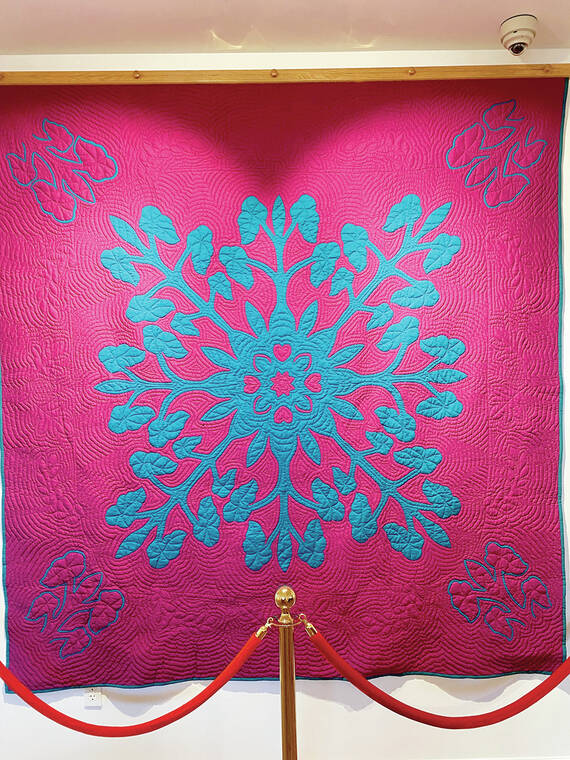LIHU‘E — Dozens of vibrant quilts line the walls of the second-story Waimakua Gallery at the Kaua‘i Museum — a tribute to the rich history of Hawaiian quilting.
“Quilting wasn’t a Hawaiian art form originally,” said museum Executive Director Chucky Boy Chock. “But the Hawaiians made it their own.”
Before the introduction of quilting, there was kapa, cloth made from beaten wauke, or paper mulberry.
When Christian missionaries introduced quilting to the Hawaiians in the 1820s, Chock explained, Hawaiians took quickly to the practice, while adding their own style.
The Hawaiians of the 1800s incorporated elements from local culture into their designs, focusing on images of natural beauty, portraying ferns, flowers, leaves and fruits. Several quilts at the Kaua‘i Museum exhibit From Kapa to Quilt feature the breadfruit design. Others show images of pineapples, moths and beetles.
They pop with bright colors — blue and magenta, orange and white, red and gold.
Quilts on display at the museum range from three-inch-by-three-inch miniatures to wall-covering behemoths. Some are more modern, while others were originally stitched in the 1800s.
Sometimes, they tell stories about local history. Polapola A Me Melemele, a red-and-purple pattern by Dean Jamieson, represents the myth of two demigods who visit Kaua‘i to introduce a new variety of bananas.
Another, Nawiliwili Beauty by Jennie Montgomery Kimble, commemorates the opening of a new harbor in Nawiliwili Bay.
“Hawaiian quilting became a form of self-expression during the period of Westernization,” writes Linda Arthur in her 2002 book “Contemporary Hawaiian Quilting.” “The Hawaiian religion, language and traditions were being lost, but some of it was preserved in their quilting.”
Hawaiian quilting took on a political dimension when, after the 1893 overthrow of the Hawaiian monarchy by pro-American business interests, quilts became a symbol of resistance to U.S. occupation.
“When the queen was arrested there was an explosion of Hawaiian flags in quilting,” said Chock, “to show support and pay tribute to her.”
Among the most-iconic quilts of this period — currently on display at ‘Iolani Palace — is the Queen’s Quilt, sewn by imprisoned Queen Lili‘uokalani. This quilt details the vital events in Hawaiian history, along with names of her supporters.
Some quilts in the Kaua‘i Museum collection are inspired by this tradition, featuring symbols like the Hawaiian flag and the kingdom of Hawai‘i coat of arms.
Chock lists some of the master quilters of Kaua‘i as Lois Kalei Montgomery, Julia Scharsch, Eme Mahikoa, Rebecca Ha‘alou, Daisy Lovell, Jennie Kimble, Mary Ho‘oiho, Elizabeth Akana, Nonna Cheathem and Rebecca Muraoka.
The exhibit will run through Sept. 28, after which the museum will display Pupu O Ni‘ihau: Jewels of the Pacific, a collection of Ni‘ihau shell leis, from Oct. 4 through Dec. 28. After being shown in Kaua‘i the quilting exhibit is set to travel to the National Quilt Museum in Kentucky.
The Kaua‘i Museum is open Monday through Friday from 9 a.m. to 4 p.m. and Saturday from 9 a.m. to 2 p.m.
•••
Guthrie Scrimgeour, reporter, can be reached at 808-647-0329 or gscrimgeour@thegardenisland.com.











